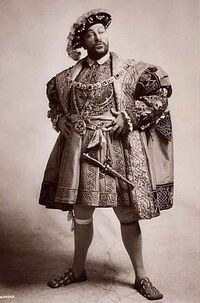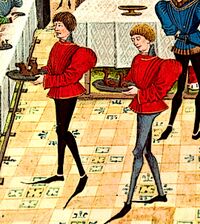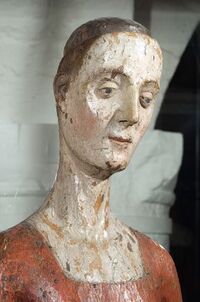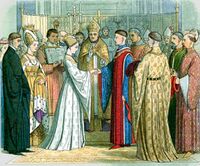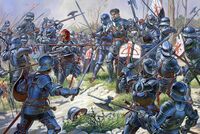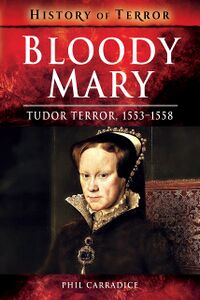House of Tudor
The Tudors! What a royal family!! Made for television costume dramas. Like the Kardashians. Blood, burnings, executions, murder, persecution, sex...and all that in the first season! A family of Welsh social climbers who went from local rebels to monarchs in 85 years. There were the two Henries, the sickly teddy boy, his young doomed Jane plain cousin, Mary the revenger of past wrongs and a queen who claimed she was a virgin and therefore guaranteed the extinction of her own dynasty. Well done Liz One.
So sit back, take off your stockings and codpiece and listen to this story.
A Lucky Break[edit]
I mentioned earlier that the Tudors were Welsh[1]. Yes, the people who lost their own country to a replacement policy enacted by the Anglo-Saxons in the centuries after the fall of the Western Roman Empire. The Welsh hero was King Arthur, a 'British' resistance fighter who was undone by his own family rather than external enemies. But he left descendants, or so was at least claimed by early Tudor propagandists. Since the Welsh changed their surnames regularly (to avoid family maintenance charges and paternity suits), the ancestral lines from Arthur look more based on imagination than evidence.
The oldest known Tudor who gave his name to the dynasty was Tudor 'Red' Hen. He was active just at the time the English conquered North Wales from its last native prince in 1282. Tudor had managed to make friends with the English before the collapse of the old Welsh order and therefore retained his lands. He was known (to the English) as the Lord of Clucks and Feathers. Tudor wobbled a few times in rebellion against the English but always managed to steer his fortunes away from going too far, abject abasement was always an option and got used when necessary.
Tudor Hen's family retained their position as minor nobility in what was in effect a conquered land. The Welsh were considered to be outside English law and were treated like dogs. This would later fuel a rebellion at the end of the 14th century under the leadership of Owain Glyndŵr. Tudor Hen's great grandsons supported Owain initially despite the family's long time loyalty to the English crown. They of course eventually deserted the cause of Owain and managed again to creep back into royal favour. In fact they did one better, one of the family got the job of apprentice knight (i.e. a squire) at the court of King Henry V in around 1415, just in time to go to France for a long war holiday.
Upwardly Mobile[edit]
Owain's participation in Henry's French wars doesn't seem to have involved much fighting. In fact we don't know his war record. He eventually qualfied as a knight and managed to hang around the court of Henry V involving himself in various menial tasks. Nothing heroic. King Henry seemed to like him personally, perhaps he liked the sound of Owain's broad Welsh accent when procurring the evening's entertainment after a hard day jousting[2]. In time Owain appears to have been attached to guard Henry's French wife Queen Catherine from lecherous hands. They were about the same age and perhaps she enjoyed looking at Owain when he wore his tight stockings at court.[3]
When Henry V died in 1422 Catherine hoped she would have some role as regent for the infant Henry VI. She was quickly shunted aside by Henry V's brothers. Katherine had become 'surplus to English requirements'. She looked after the young king at first but boy monarch was soon put in the hands of harsh tutors. Her only ally at court was Owain. The expectation was that after a decent interval, Catherine would 'retire to a nunnery' in due course and moulder away. Instead the couple eloped and arranged a secret marriage to legitimise the affair. This was a true love match. Catherine was the daughter of a French king (Charles the Mad) and claim ancestory from Charlemagne. It was the mismatch of the century but the couple were happy. At least two sons were produced from their union, possibly a third boy and a daughter[4].
Perhaps because they were busy with France, the court of Henry VI appears not to have known of the affair and marriage at first. When they found many in King Henry VI's regency government wanted Owain to theatrically executed for his sexual audacity. Catherine was sent to a nunnery and soon died, aged about 35. Owain was sent to prison to await death if the young Henry wished it. However Henry forgave Owain for his 'sins'. He liked having brothers. The semi-royal urchins Edmund and Jasper Tudor were granted lands and titles equal to other members of the English aristocracy. It beat ending up in the cesspits.
Child Marriage[edit]
In 1452 Edmund Tudor (now the Earl of Richmond) and his brother Jasper (Earl of Pembroke) were invited to court and encouraged to find suitable brides. Despite their lowly origins, they were half brothers to the king and that was important. Edmund (being the elder) was linked up with the Beaufort Family, originally a royal bastard family off-shoot of the ruling Plantagenets. This made sense. Other English nobility regarded both the Beauforts and Tudors as outsiders, conveniently enobled by earlier kings. Then a year later Henry VI lost his marbles and sat around in his nightshirt for the next 18 months, staring blankly at no one. This allowed Henry's cousin Richard Duke of York to become Protector of the Royal Privates.
York's rise to power persuaded the Beauforts and Tudors to team up immediately. A marriage alliance was proposed. There was a Beaufort heiress, Margaret but she was aged 10. No matter, a deal was sealed - just in time for Henry to recover his marbles and to be surprised that his queen had given birth to a boy (Prince Edward), hence a nephew of both Edmund and Jasper.
Edmund's marriage to his child bride didn't last long. The outbreak of the War of the Roses saw Edmund sent to Wales to keep that country on the Lancastrian side. In 1456 he got himself captured by a Yorkist army inside Carmarthen Castle. There he was imprisoned and very shortly died, officially of bubonic plague but more likely poison or suffocation with a pillow. It had been a short and inglorious life. Edmund's bride Margaret gave birth to their son Henry, Earl of Richmond at Pembroke castle. He would later become King Henry VII, Now without a father, young Henry became a ward of his uncle Jasper, as did his mother Margaret. Perhaps needing the money, Jasper had Margaret remarried into another noble family (The Staffords) with the hope securing allies for the Lancastrians.This deal was sealed with a dowry, i.e. a bribe for a bride.
On the Run[edit]
After a lull of a few years, the War of the Roses sparked back into like in 1459. Jasper Tudor and his father Owain remained staunch Lancastrians. However neither could be classified as successful commanders. Jasper Tudor's army was defeated in battle in 1461, obliging Jasper to escape to France. Owain wasn't so nimble. He was captured. Edward Duke of York (later king as Edward IV) who was the Yorkish commander had been expected to ransom Owain but as the Lancastrians had recently killed his own father, Edward wasn't in a forgiving mood. He ordered the public execution of Owain, now a distinguished 60 year old. Owain had his head removed.
The young Henry Tudor (aged four) became a ward of Lord William Herbert. This was the same man who had been responsible for capturing Edmund Tudor earlier. Henry's income as an earl went to Herbert (after deductions to the royal exchequer). In return Henry was supposed to learn the arts of being a lord. He would have undergone training as a knight, learn to read and manage his pocket money. Despite his relative personal poverty, Henry was still a descendant of King Edward III via his mother Margaret and a 'red rose' family. That cause appeared to be dead as the Beaufort family shared the misfortunes of executions and exile along with the Tudors.
The Lancastrian cause (and therefore the Tudors as well) improved in 1469 when the Yorkists fell out amongst themselves. Henry Tudor's guardian Herbert was one such casualty. This lead the restoration of Henry VI as king and the return in favour of Jasper Tudor. He got back his lands and importantly, also of young Henry Tudor. The Lancastrian restoration was short lived. In 1471 they were defeated. The heir to the throne Edward Prince of Wales and Henry VI were killed whilst the Beauforts were physically eliminated. This left only Henry Tudor and he was on the run with his uncle to France. They had no choice. Jasper could expect no mercy and Henry Tudor would have ended up in prison for life.
Kingship[edit]
There were now very long odds against Henry Tudor becoming king of anything, except perhaps a row of French sandcastles. By accident, Henry and Jasper had landed not in France but in Brittany, at this time a semi-independent state, to which it was useful to hold onto Henry as a guest-in-a-castle-without-a-front-door-key. King Edward IV offered money, but Brittany was holding out for a military alliance against France. Henry spent every day wondering if his Breton hosts would turn on him and post him back to England in chains.
Henry got a serendipitous boost toward kingship when a royal cull broke out among the Yorkists. It started in 1478, when Edward IV ordered the death of his younger brother George, Duke of Clarence and had the latter's son debarred from the royal succession. In 1483, Edward suddenly died from a heavy cold. He was succeeded briefly by his son Edward V, until his uncle Richard, Duke of Gloucester, deposed him for being a 'bastard'. Richard (as Richard III) then in turn had Edward and his younger brother Richard, Duke of York murdered in the Tower of London. This would have been fine as Richard III had his own son but his boy (also called Edward — confusing, huh?) then also died of bad indigestion and was followed not long after by his wife, Queen Anne.
During this time, Richard III made a renewed effort to get his bloody hands on Henry Tudor. The latter had now lost all trust for his host — Duke Francis was now quite mad — and moved castle from Brittany to France proper. The French kingdom had its own minority rule under King Charles VIII. His elder sister, Anne, was the acting regent and supported Henry to gain the English throne. Her motives are obscure but her money let Henry organise an army to invade. He did that in 1485 and in August of that year, his army killed Richard III at the Battle of Bosworth. That marked the end of the Plantagenet kings. This would now be the age of the Tudors.
Connections[edit]
Henry's first acts as king was to 'secure his bride' (gain custody) of Elizabeth of York, the eldest surviving daughter of Edward IV. His second one was to imprison Edward, Earl of Warwick in the Tower of London. The latter was only a child but because of recent family tragedies (murder and death in battle), he was the last male legitimate Plantagenet. What wasn't done was to make any search for the missing Edward V or his brother Richard, Duke of York. Since Henry didn't want them to re-appear (alive) and challenge his claim to the throne, Henry evidently calculated he could just carry on as if they never existed.
The problem Henry faced was obvious. He only became came through an alliance of Lancastrians and disgruntled Yorkists. Now that Richard was dead that combination looked wobbily . People who had betrayed kings earlier (here's looking at you the Earl of Northumberland) could do it again. Henry could wake up with a dagger in his back. All they would need a plausible candidate, it didn't even have to be the real deal. Any impersonator or an imposter would do. Though the real Earl of Warwick was in prison, many Yorkists had rallied around a supposed true Warwick (called Lambert Simnel) who got as far as being crowned 'Edward VI' in Dublin. The rebels here were defeated and their fake king re-assigned to the royal kitchens to turn a roasted pig on a spit. The second challenger called Perkin Warbeck came up with the story that he was Edward V's brother Richard. Though never crowned, Perkin gained enough support to answer letters in the name of 'Richard IV'.
These rebels were never strong enough to gain enough support to endanger Henry's throne. They had strong nuisance value but were helped by one Tudor failing. A lack of surviving family heirs. Henry and Elizabeth had four children who survived into relative adulthood. Two daughters Margaret and Mary were married into the royal dynasties of Scotland and France. Henry's eldest son Arthur was married to Catherine of Aragon but died of a bad cough. His younger brother Henry was still a snotty young teen and barely scraped past the age of legally buying his own alcohol when he succeeded as king Henry VIII in 1509.
Ambitions[edit]
We all think we know Henry VIII. A man of gargantuan culinary and sexual appetites. Ruler for 38 years, Henry got through Six Wives of Henry VIII|six wives]], the Catholic church and kept his executioners busy with beheadings, boilings, burnings,hanging and murder. The English loved him. What a character for a king. Far better than his contemporaries like Holy Roman Emperor Charles V or the French king Francis I.
However on a dynastic front Henry is considered to be a huge failure. His three surviving children would fail to produce any children either on the grounds that they became monarch too young or too old and in one case, deliberately refused to marry to avoid having a 16th century husband.
Relgious switchbacks[edit]
You may be surprised to learn that Henry VIII died a Catholic - just one who didn't like popes. His henchman had Thomas Cronwell and Thomas Cranmer (archbishop of Canterbury) had created this thing called Anglicanism. It was sort of Catholic-lite in many ways. Holy relics were discontinued, no more pilgrimages. Also frowned upon was 'idoltary' and that led to statues of Jesus and Mary getting moved to the cupboard. For older generations this was a bit difficult as they have been baptised Catholics and now feared there was an anti-Christ around the corner.
Henry's son King Edward VI was just nine when his father died. His mother's brother Edward Seymour became the Royal Sheath Protector. He was keener Protestant than anyone in power before and pushed for more of a radical change. This lead to a series of rebellions throughout England and eventually saw Seymour removed from office. Before then he had awarded himself the vacant dukedom of Somerset but that didn't save him from losing his head in 1552. King Edward noted coldly that his uncle had been beheaded and celebrated with a vigorous bible reading and self beatings. The latter course of action as had inherited syphilis from his lovely dad.
Edward's health declined quickly and he died in 1553. He left three women to scrap for the throne:His sisters Bloody Mary and Fruity Elizabeth and a cousin called Lady Plain Jane Grey. The late king's chief minister John Dudley, 1st Duke of Northumberland was determined Mary wouldn't get the throne and distrusted Elizabeth for her previous involvement with the Seymour family. Northumberland put Jane forward as queen because (a) she was very young and (b) was his daughter-in-law after marrying his son Guildford Dudley [5]. Jane's reign was very brief,a week and two days to be exact. Proclaimed queen Regnant (i.e. in her own right), Jane was technically England's first true female monarch since the 12th century[6]. However few people rallied to her and Mary defeated Northumberland and his cohorts. He was executed after a short trial. Jane and her husband survived a few more months until Mary green-lit their executions too.
Mary was a full on the nose Catholic. For many other European powers she was the only legitimate child of Henry VIII. Mary had been shunned, bastardised and internally exiled by her father but he had never legally debarred her from ever succeeding. Hoping to make up for lost time (she was 37), Mary went on a search for a suitable husband. Her choice was foreign so she asked if her cousin Philip of Spain if he fancied the idea. He did. Philip came over. His idea for entertainment was burning Protestants. It became Mary's hobby too.
It wasn't a successful marriage. Mary was unable to get pregnant and Philip spent more time in Europe, sending updates of his adventures to his bride. Mary contrived to get her sister Elizabeth to become a Catholic but she refused. Even an extended stay for Liz in the Tower of London didn't change her mind (she was given the worst guest room/prison cell in the building. Mary hoped to persuade Philip to agree to a very bad end for Elizabeth but he disagreed. The next heir to the English throne was Mary Queen of Scots and she (and Scotland) were de facto pawns of the French. So Elizabeth survived and Mary grew more bloody minded until her death in 1558, a demise hastened when she tried to have the word Calais engraved on her heart. She had lost England's last French possession (if you discounted the Channel Islands and most people do), marking the formal end of England's first overseas empire.
Virginity and Killing a Rival[edit]
Now starteth the reign of Good Queen Judi...I mean Queen Elizabeth I. A time of drama in court and on stage. Elizabeth had gone through the same love/hate/rejection path her elder sister Mary had experienced with their father Henry VIII. Elizabeth had managed to keep her head when Mary wanted it removed. Another Mary (from Scotland) said her cousin had no right to it as she was a heretic. She also locked up her cousins in the Grey family as possible dynastic rivals. The Scottish queen eventually ended up Elizabeth's prisoner as well and for not dying in jail from the insanitary conditions, had her executed in 1587.
Elizabeth said she was a perpetual virgin and at the same time made enquiries about possible throne mates. One of these considered was Robert Dudley, Earl of Leicester and the son of the disgraced John Dudley who had supported Lady Jane Grey as queen in 1553. Liz and Dud (as they were called behind their backs) seemed natural bed fellows but other English nobles were oppossed. Elizabeth then got her international contacts book and looked at who was available from France and Germany. The royal French prince Francis (brother of King Henry III of France) and Archduke Charles rival from Habsburg came over to England to peacock around the English court. Neither seemed suitable on many grounds but largely that were both were devout Catholics. Did this mean Elizabeth was thinking about converting? Evidently not. There were other Protestant kings to choose from but one of these King Eric of Sweden was insane.
Later on in Elizabeth's life she meet the Earl of Essex. She was by then in her 60s and wore make-up four inches deep to cover her advancing age. She still outlived Essex, if on a technicality of executing him for treason and ghost writing all of William Shakespeare's plays in 1601.
Influence[edit]
Queen Elizabeth died in 1603 and with it the Tudor name. True, there was for awhile another Tudor dynasty in Wales, descendants of Owain Tudor's elder cousins. This branch of the family had never risen above the level of head porter back in Wales and received no favours from their more famous namesakes. They disappered in the late 17th century, their lives so barely recorded that only records of them being involved in a legal case indicates their historical presence.
The family never felt their power was secure. In the earlier years it was stamping out any remaining Plantegents. In later years it was imprisoning and executing cousins for their religious sympathies as much as anything else. What they were not was dull. And for anyone who likes a good story, that is definitely a sin!
References[edit]
- ↑ The spelling of the surname varies. Sometimes it is Tudor, other times it is 'Turdor' or 'Turd door', which translates as keeper of the key to the communal privy
- ↑ Generally quite filthy stuff
- ↑ Catherine called him 'Tudi' as a pet name
- ↑ The youngest son Edward became a monk, the daughter Margaret died young before she could be married off (i.e. aged 12).
- ↑ Jane had turned down Guildford's other brothers Dorking and Woking
- ↑ Matilda who was the heir of King Henry I held a similar title but had never been able to defeat her rival Stephen who had the benefit of being crowned. Matilda never was.
| ||||||||||||||||
